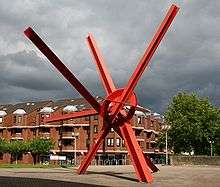Are Years What? (for Marianne Moore)
|
| |
| Artist | Mark di Suvero |
|---|---|
| Year | 1967 |
| Type | Steel |
| Dimensions | 12 m × 12 m × 9.1 m (40 ft × 40 ft × 30 ft) |
| Location | Hirshhorn Museum and Sculpture Garden, Washington, D.C., United States |
| 38°53′20″N 77°01′24″W / 38.88893100°N 77.02341600°W | |
| Owner | Smithsonian Institution |
Are Years What? (for Marianne Moore) is a sculpture by American artist Mark di Suvero. It is in the collection of the Hirshhorn Museum and Sculpture Garden, in Washington, D.C., United States.[1] The sculpture is named after poet Marianne Moore's "What Are Years".[2] Temporarily (through May 26, 2014), the sculpture has been relocated to San Francisco, as part of the San Francisco Museum of Modern Art's Mark di Suvero exhibition at Crissy Field.[3]
Description
This 10-ton[2] sculpture is made of nine[4] red-orange[5] steel I-beams, welded together, with one section suspended as a giant mobile with wire, shaped like a "V".[4][6]
Information
Are Years What? (for Marianne Moore) is signature of di Suvero's monumental early 1960s "open-work constructions." These works utilize cast-off construction materials like chains, metal bars, and ladders. This sculpture is the first that di Suvero built, from beginning to end, with I-beams and using a crane, solely by himself.[2][5]
Acquisition & installation
Are Years What? was originally in the collection of the artist, then the collection of Enrico Martignoni of Winnemucca, Nevada.[1] Hirshhorn director James Demetrion first saw the sculpture when it was on display in Brooklyn's Prospect Park.[4] The sculpture was acquired by the Hirshhorn with funds from the Joseph H. Hirshhorn Purchase Fund, a gift from the Institute of Scrap Recycling Industries, and by exchange of the di Suvero artwork ISIS,[4] in 1999.[1] The sculpture was installed on June 13, 1999, by crane into the museum's sculpture garden.[7]
Reception
The dangling "V" shaped piece of the sculpture has been described as representing the prow of a ship, or, as by art critic Irving Sandler as a representation of di Suvero's family's maritime heritage in Venice. Sandler also stated that the acute angles have male and female associations, with the horizontal representing a penis and the vertical "V", a vagina, which di Suvero does not associate with the work. The "V" has also been suggested to represent birds in flight or a "V" for victory.[8] Jayne Merkel believed that Are Years What? exploited the strengths of the I-beams yet "at the same time, he has made a piece that is graceful and well balanced - aesthetically pleasing and intriguing from a number of points of view."[9] Upon the sculpture's installation at the Hirshhorn, The Washington Post received the work as "brilliant in conception," "prominent, beautiful and memorable. It lifts the heart and stays in the mind. It is a gift to the city and all who visit."[4] Are Years What? is considered by some to be di Suvero's "breakthrough work."[10]
Exhibition history
- Solo show, 1997, Jeanne-Bucher Gallery, Paris
- Solo show, 1995–1996, Storm King Art Center, Mountainville, New York
- Solo show, 1995, Venice Biennale, Venice, Italy
- Solo show, 1994–1995, Valencia Museum of Modern Art, Valencia, Spain
- Mark di Suvero Retrospect, 1991, Museum of Modern Art, Nice[11]
- 1988, Wurttembergischer Kunstverein, Stuttgart, Germany
- Prospect Park, 1975–1976, Whitney Museum of American Art, New York, New York[1]
- Sculpture off the Pedestal, 1970s, Grand Rapids, Michigan[12]
- Plus by Minus, 1968, Albright-Knox Gallery, Buffalo, New York[1]
Gallery
-
-
-
-
-
Deinstallation of Mark di Suvero's sculpture, "Are Years What? (for Marianne Moore)" at the Hirshhorn Museum Sculpture Garden, May, 2013
See also
- Aurora, 1993, National Gallery of Art Sculpture Garden, Washington, D.C.
- List of public art in Washington, D.C., Ward 2
- The Calling, 1982, O'Donnell Park, Milwaukee, Wisconsin
- Snowplow, 1968, the Indianapolis Museum of Art
References
- 1 2 3 4 5 "Mark di Suvero". Collections. Hirshhorn Museum and Sculpture Garden. 2007. Archived from the original on 2011-06-29. Retrieved 23 April 2010.
- 1 2 3 AlbinoFlea (2006). "Mark di Suvero's Are Years What? (for Marianne Moore)". Sculpture. Virtual Globetrotting. Retrieved 23 April 2010.
- ↑ "SFMOMA On the Go". Retrieved 8 September 2013.
- 1 2 3 4 5 Benjamin Forgey (16 October 1999). "Splendor on the Grass". The Washington Post.
- 1 2 Morgan, Ann Lee (2007). The Oxford Dictionary of American Art and Artists. Oxford University Press. ISBN 0-19-512878-8.
- ↑ Hirshhorn Museum and Sculpture Garden (2008). "Are Years What? (for Marianne Moore), (sculpture).". Inventories of American Painting and Sculpture. Smithsonian American Art Museum. Retrieved 23 April 2010.
- ↑ Don Hurlbert (1999). "Installing Hirshhorn Sculpture". History of the Smithsonian. Smithsonian Photographic Services Collection. Retrieved 23 April 2010.
- ↑ Jan Garden Castro (2005). "To Make Meanings Real: A Conversation with Mark di Suvero". Sculpture. Retrieved 23 April 2010.
- ↑ Merkel, Jayne (1971). "Brilliant New Showplace on Government Square: Contemporary Arts Center". Cincinnati Magazine. Emmis Communications. 4 (4): 35.
- ↑ James Chute (2011). "Mark di Suvero is a man of steel". San Diego Union-Tribune. Retrieved 23 April 2010.
- ↑ "Archived copy". Archived from the original on 2012-04-13. Retrieved 2011-11-28.
- ↑ Jeffrey Kaczmarczyk (2011). "Sculptor Mark di Suvero honored by Nobel Peace Prize–winner Barack Obama at White House with National Medal of Arts". Grand Rapids Entertainment. Michigan Live. Retrieved 23 April 2010.
Further reading
- Kardon, J. "1967 at the Crossroads", Institute of Contemporary Art, University of Pennsylvania Press, 1987. Exhibition catalog.
- Lyons, J. Washington, D.C.: A Pictorial Celebration. Sterling Publishing, 2005. ISBN 978-1-4027-1527-3 Features Are Years What? in pictorial
- Richard, P. (29 August 1999). "Here & Now". The Washington Post.
External links
- Are Years What? (For Marianne Moore) from di Suvero's website, on display in Venice.
- "What Are Years" poem by Marianne Moore
